A report out today from the Portland Business Alliance, our regional chamber of commerce, is the latest argument that bike and freight transportation really ought to be close allies.
An unexpected 3 p.m. traffic jam, for example, can lead to a canceled flight, which can cost Intel precious hours in the short lifespan of important dyes used in Hillsboro chip factories.
“They’ve tightened down their supply chain so much that they’re relying on a very complex set of links so that if one fails, then it throws them into a tizzy,” said Susie Lahsene, transportation and land use policy manager for the Port of Portland. “It really throws off the operation and they have to overcompensate. … If it’s completely unpredictable, if it’s episodic, that then really creates a problem.”
As Oregon’s streets and freeways have gotten more crowded, the state’s freight businesses have been driven to use increasingly complicated tactics to avoid such snarl-ups.
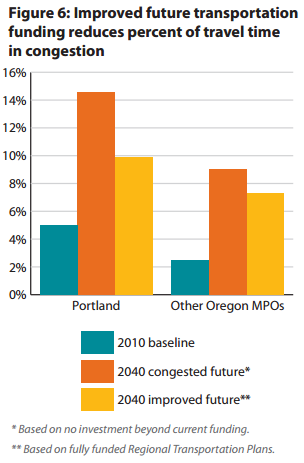
“Many respondents reported that they have implemented staggered shifts, added evening and overnight operations, and are increasing operation during ‘off-off-peak’ hours, with some delivery shifts now starting as early as 2 a.m,” the report says. “However, the businesses are making these operational changes in the face of regulatory limits on driver hours, worries of driver safety and limits to when they can feasibly deliver to customers. For those businesses that cannot shift to off-off-peak hours, managers report ‘lost turns’ on truck deliveries due to congestion, meaning that a truck can take on fewer delivery routes in a day compared to the recent past when there was not as much congestion.”
To avoid such problems getting worse, the report calls for full funding of the state’s regional transportation plans. According to Portland Metro calculations (see chart), the total amount of Portland travel time that vehicles spend sitting in traffic is expected to increase from 5 percent in 2010 to almost 15 percent by 2040.
If Metro’s regional transportation plan is built, Metro calculates, congestion will merely double to 10 percent of travel time.
Advertisement
What’s in this regional transportation plan? Well, it includes new high-capacity transit lines connecting Tigard, Lake Oswego, Milwaukie and Clackamas…
…a connected network of biking-walking paths…
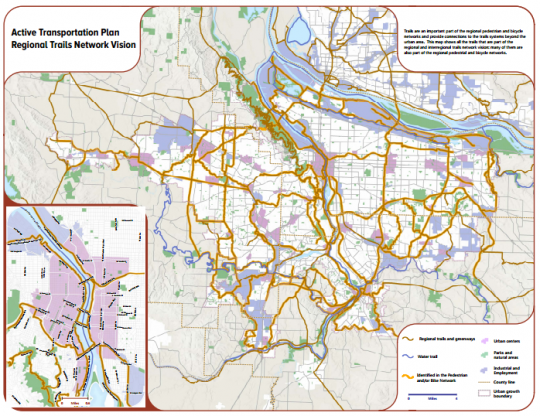
…and also several billion dollars in wider or more-connected urban highways, freeways, barge and freight rail connections (here’s a sample from Metro’s long wishlist).
In its report, the PBA argues that a region that is “uniquely trade-dependent” — the state’s trade-related employment grow 7.5 times faster than total employment from 2004 and 2011, the report says — is counting on anti-congestion efforts for economic growth.
As many BikePortland readers will argue, of course, wider roads are about as good at solving congestion as free ice cream cones are at solving hunger. The daily traffic jams on freeways are as predictable as the long lines on freebie day at a Ben & Jerry’s.
So it’s a little odd that the PBA’s nicely assembled report (and the Metro policymaking that it’s based on) don’t seem to consider the possibility of reducing congestion by charging people to drive on roads and freeways during peak hours.
Intel, presumably, would be happy to pay an anti-congestion charge if it never had to miss a flight again.
Lahsene, the Port of Portland policy manager who works with the PBA on these issues, said anti-congestion pricing is mostly absent from the region’s conversation not because it’s a bad idea but because it seems politically inviable.
“I just think as a region and as a state we’re not quite ready, as evidenced by the fact that we have very little tolling on other parts of the freeway system,” she said.


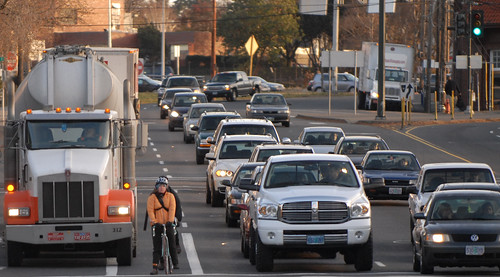

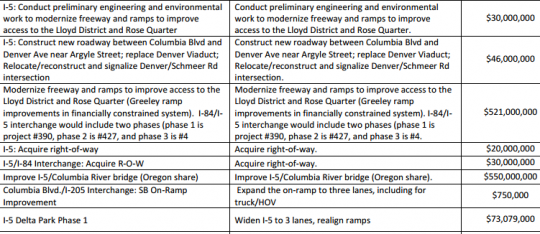


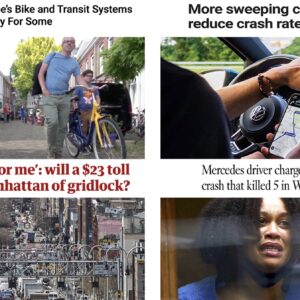
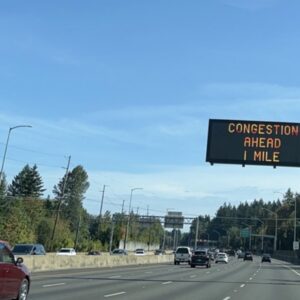
Thanks for reading.
BikePortland has served this community with independent community journalism since 2005. We rely on subscriptions from readers like you to survive. Your financial support is vital in keeping this valuable resource alive and well.
Please subscribe today to strengthen and expand our work.
I have to agree with Lahsene that the idea of congestion pricing “seems pretty inviable.”
The Congress, state legislature, and local elected officials can’t even seem to generate sufficient backbone to raise gas taxes in line with inflation.
As I’ve stated previously, since 1993, the last time the federal gas tax was increased:
Construction costs have increased 70 percent;
The Oregon gas tax increased by 25 percent (from 24 cents/gal to 30 in 2011);
The federal gas tax unchanged.
Adjusted for inflation, Oregon’s gas tax should be 42 cents per gallon (using 1993 as a base). What’s the chance the state legislature will come up with a gas tax increase of 12 cents per gallon?
“not because it’s a bad idea but because it seems politically inviable”
Haven’t we heard this argument applied to the unmentionable hike in the gas tax? Seems like maybe this is a clue. When someone says ‘this is politically inviable’ then it is probably not just a good idea but an urgent matter.
And while we’re at it, what about falling VMT? Did anyone at the PBA think to acknowledge this?
There’s some evidence to suggest that peak period traffic is increasing even though daily VMT may be flat or falling. The explanation is that people are cutting down on their off-peak discretionary trips, but with employment rising, the peak hour commute trips are continuing to increase.
I can think of lots of things that are worth billions of dollars in investments.
Relieving highway congestion (for only 4-6 hours of the twenty four hour day) by as much as 5% isn’t one of them.
7.5 times faster job growth! That unbelievable! Literally.
Keep in mind that the “trade related” sector is represents only a portion of total employment. Total employment growth is relatively modest, manufacturing is flat, services are increasing, but there’s more import-export activity. That’s where the high growth in trade-related employment factors in. Some in in tech; some in agricultural exports; some in resources like potash.
Agree. However, the 7.5 times faster is still obviously bunk. Note the years chosen. 2004 and 2011. Comparing a good year to a recessionary year to get the result they want. Why not 2002 and 2014? If they are willing to rig those numbers, why should I trust any other numbers in this report?
Wow. Sadly common in economics consulting, especially on projects for businesses and their lobbies (I used to be in the industry). Greatly misrepresenting the truth through numbers-picking.
Good luck getting the suburbs to go along with this after all the anti light rail measures that have passed. Sometimes I feel like there’s small groups of angry mobs out there with pitchforks, ruining something out of fear because they don’t understand it.
<sarcasm>
Anything new is bad.
Scientists and intellectuals are the devil’s minions.
Science is Satan himself.
</sarcasm>
At least… I hope it’s sarcasm.
The same can be said for the proponents of light rail, street car, wes. Have any of these lived up to the hype?
MAX is pretty awesome, if you consider the scale of the investment in it (in both money and land) was absolutely infinitesimal compared to the investment in highways and roads for private motor vehicle travel.
I think MAX is a huge success. As for the streetcar, on a daily basis at a multitude of different times I see the streetcars packed with plenty of people downtown. I think it can suffer from the same issue buses have with congestion, though. If a streetcar line were built directly up west/east Burnside with a bus/streetcar only lane during rush hour in each direction on the bridge, I’m quite sure it would be popular too.
WES loses money and the streetcar ridership numbers have been inflated.
Has the PBA thought about how driverless/drone delivery will affect congestion? This is the killer app for congestion. Amazon and Google will have a lot to say about how freight is delivered in the near future.
How many vehicles are removed from the road when 100 people no longer need to drive to a grocery store because either they are all walking distance from every residence or a single delivery truck is delivering their groceries?
If a “stand on your own 2 feet” red state like Utah can figure out and fund free housing for chronically homeless people because it massively saves money on all other services could PBOT consider economic incentives for people to partake in delivery services so that they drive less?
Bigger roads, traveled by bigger vehicles = more air pollution.
People need clean air to walk and ride a bicycle.
The report was written by an economic development consulting firm. How about a similar report conducted by staff at the at the New Economics Foundation?
Actually large delivery vehicles produce less pollution than smaller vehicles delivering smaller loads.
I guess that depends on how small. When I use my delivery vehicles there is no pollution that I am aware of.
Someone simply needs to explain to the PBA that if you complete all of those proposed high capacity transit lines, the network of biking and walking paths, and increased rail capacity, the need for the wider roads would be greatly reduced, if not extinguished.
Exactly. I think we need more rail transit specifically. Buses are slow – often caught in the same congestion as other vehicles – and cause a lot of damage to roads.
“Buses are slow”
As opposed to light rail?
Light rail is slow downtown where it stops frequently, but at least it has signal priority and its own lane/right of way. Biking over the Burnside Bridge I frequently see buses at rush hour – especially in the afternoon – backed up behind one another due to traffic congestion. It’s bad for cyclists in that location too because they block the bike lane at each stop.
I sometimes take the #20 home, boarding from Burnside/Sandy. Looking west, you can see the buses all the way down to the west end of the bridge. Yet sometimes it take 15 minutes for buses to transit that small stretch.
I’d rather see a commuter rail network (e.g. WES) built out for connecting the suburbs. Preferably with Bombardier bi-level trainsets.
Super-expensive unless you have higher levels of ridership. You might be able to fill a train on the I-5 corridor, but lines don’t have enough capacity.
Build it and they will come.
Many commuter lines across the country use existing freight lines. Does anyone have the exact numbers on cost vs. light rail? I’d imagine that the price of laying new track would be higher than the price of leasing track from BNSF/UP/P&W.
Have you seen the official Trimet ridership numbers and cost per rider for WES? It averages 1800 riders per day with a cost of just over $15 per rider. That works out to a public subsidy of close to $300 per month per regular commuter. We can’t afford to have that type of system expanded.
I’m a fan of transit, but not suburb-to-suburb heavy rail fixed route service. What a waste.
Bingo. Even the comparatively successful Sounder service in Seattle has a cost per boarding around $12. The freightv rail corporations really take the government to the cleaners on the easements, and the trains are generally only full in one direction. Until our government starts prioritizing rail investment, and stops subsidizing trucking, this is going to be the case.
You guys may know better than I do, but I think another major factor in the cost per rider of commuter rail such as WES is the “railroad” specific federal labor law that requires two employees to be on every train. For whatever reason, MAX isn’t considered a “railroad” for this purpose.
Well-built, double axle buses are needed. Buses are needed over trains in emergencies.
I like that Intel complains about congestion, then asks the state for tax waivers. Maybe if they paid the same taxes as the rest of us, that could help solve THEIR problem. Their tax avoidance tactics are a form of Corporate welfare, that they now want us to solve for them.
Yeah I was thinking that perhaps Intell should invest billions more to the farm so they don’t have to rely on traffic for their precious dies.
And if connectivity to PDX is so important, why did they build their campus on the opposite side of the metro region?
Why can’t these shipments be flown in and out of Hillsboro Airport? Seems to me that investing in that asset makes more sense than trying to “improve” a long, silly trip that Intel brought upon themselves by locating far from PDX.
What about converting general travel lanes to commercial-vehicle-and-bus-only lanes? I could see that going somewhere politically….
For example, on Powell in the Powell/Division transit project.
I would be 100% excited about making I-5 between the Ross Island Bridge and the Columbia River into freight-and-bus only. Clean that congestion problem right up!
I don’t think we should be making “commercial vehicle” lanes. Some of the biggest transportation parasites are the commercial contractors driving full-size pickups, and writing off everything as a “business expense”.
I can see that. If there’s a commonly-accepted definition of “freight” then that seems like a better way to go.
The obstacle to moving freight in the peak hours is too many commuters alone in their cars. Make room for freight by giving those commuters reliable and safe options…transit, carpool/vanpool, and bike exclusive right of ways. Its what Swan Island TMA has promoted since 2000.
Put a toll in the I-5 bridges, stripe HOV/Freight lanes in both directions.
Note that 1000 people work at adidas, a key traded sector employer, but not one shoe is shipped out of PDX…its a bit more complicated than the “more roads” advocates like to say. Portland’s biggest container export? Air…as in empty containers; next is straw for feed.
Shipping entities (trucking, train, & airfreight) should pay a larger portion of their business model needs. Blueberries arriving by 747 from Chile in January isn’t a sustainable business model and doesn’t inspire me to help widen the roads. It’s time to update (raise) the weight mile fee that truckers pay. You want to buy cheap imported products, then pay ALL the shipping costs. We need to encourage manufacturing to stay local, not subsidizing the shipping of imports, is a start in that direction. Helping pay for their needed infrastructure hides the true cost of those “cheap” imported products.
I realize that shipping is a huge part of Portland’s economy, but shipping the average meal 1500 miles is not sustainable for the long term. The problem is deeper than just wider lanes, but who pays?
Hear, hear!
Glad to see Metro has its priorities in line. No highway expansions, extensions, or new roads. The only highway projects seem to be improving on/off ramps. The regional high-capacity transit plan would be fantastic if built out. A commuter-style rail (e.g. WES) makes more sense for connecting the further-out suburbs.
It’s really inefficient to spend thousands of millions of dollars expanding roads because of problems faced by 1% of the traffic on them (while freight is probably 5-8% of traffic, super-time-sensitive freight is a small fraction of that).
And the whole time-spent-in-congestion is a bad measuring tool; total travel time is what should be measured. By time-spent-in-congestion method, a 60 minute commute to Salem is more efficient than a 15 minute commute to downtown Portland, if 5 minutes of it is spent in congestion.
The most efficient investments will shift people out of cars or out of rush hours — hence transit, bike, ped, telecommute, etc. Those have multiple benefits in health, environment, and traffic flow.
Freight-only lanes sound like an excellent pro-business way to limit the growth of congestion.
Reduce congestion by charging people to drive on roads and freeways during peak hours–yes! I’m looking out at the now-familiar ring of smog surrounding Portland and trying to imagine yet more traffic cramming in every year. Impossible. Also–no more free parking! As for freight–I might’ve seen you cover this here? http://www.citylab.com/tech/2014/09/los-angeles-is-building-an-e-highway/380914/
Reduce parking throughout The Metro region. Put a toll on the I-5 bridge across the Columbia, congestion charge on the highways and use one of the existing I-5, 205 and 405 lanes as HOT/BRT/freight only. These steps will reduce congestion.